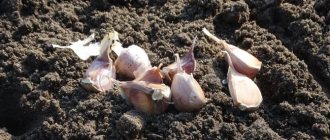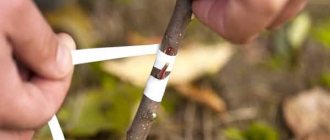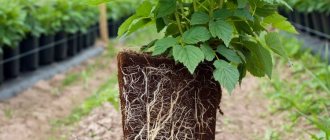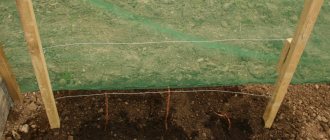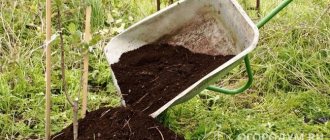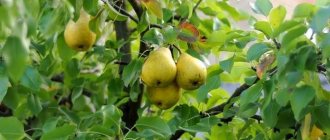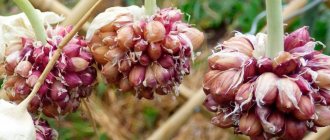Planting raspberries in summer: pros and cons
Of course, it is best to plant seedlings in spring or autumn, when the weather is warm outside and the soil is quite moist.
- But summer planting has its advantages:
- urgent planting of a accidentally acquired cutting of the desired variety;
- seedlings with a closed root system take root easily;
- at the beginning of summer, green root shoots appear, which can be used to propagate raspberries;
- You can get a harvest in the first year, 2–3 months after planting.
But you shouldn’t organize mass raspberry plantings in the summer.
- This method has significant disadvantages:
- in the southern regions it is not recommended due to very hot and dry summers;
- the first 2–3 weeks require daily monitoring of soil moisture;
- Shading may be necessary to prevent the planted sprouts from being burned by the hot sun.
Planting raspberries in August using the trench method
The most acceptable method of planting in the summer is the trench planting method. It should be taken into account that weather conditions are favorable for rooting and growth of green mass. In hot and dry periods, such an undertaking will not be successful.
Preparatory steps before planting raspberries:
- In one week, preferably three, it is necessary to remove all the weeds; this will prevent the bushes from becoming infected with viral and bacterial diseases, and will also preserve all the nutrients.
- Dig up the area with a shovel or plow with a walk-behind tractor.
- If increased acidity of the soil is detected, it is necessary to add dolomite flour or wood ash.
- Form trenches 40 centimeters deep and 60 centimeters wide.
- Place compost and mineral fertilizers or manure at the bottom, as well as wood ash, cover the fertilizer layer with soil to prevent burns to the roots.
- Construct a trellis so that the bushes have a garter and receive a sufficient amount of sunlight from all sides. The most basic type of trellis is pegs with stretched wire or rope.
Variety selection
You can plant different varieties in the summer, especially those with a closed root system. When choosing a variety, you need to pay attention to its characteristics:
- frost resistance;
- drought resistance;
- immunity to disease;
- productivity.
Preference can be given to remontant varieties with early ripening. Seedlings in containers quickly take root and will be able to bear the first berries by autumn.
The best varieties
In early spring and autumn, seedlings are planted in prepared soil. But gardeners have gotten used to doing this in hotter and drier times of the year. Benefits of summer planting:
- the ability to urgently plant or transplant a cutting;
- plants with a closed root system take root better;
- The first harvest can be obtained in the same year.
But it is necessary to choose the right variety, which would have good frost resistance and drought resistance. It is useful if the plant is immune to common ailments. Early ripening and remontant varieties are often chosen. They are the ones who can produce the first harvest in the year of planting.
Early ripening
Popular among experienced gardeners and beginners who want quick results. Breeders offer a wide range. You can choose from the following varieties:
- Bryansk miracle. Rich taste and aroma of berries, frost resistance. Does not tolerate prolonged drought well without additional watering.
- Hercules. It produces a harvest twice a year, there is no need to remove the shoots. It is characterized by high yield, but the taste of the berries is inferior to other varieties.
- Zyugana. High rates of transportability and berry preservation. Suitable for industrial cultivation.
Care for such plants is special. They require intensive feeding when planting. It is useful to regularly inspect raspberries for the first signs of disease, even if the variety is immune. It is important to carry out preventive treatments on time.
Bryansk miracle
Mid-season
More often they are immune to most common diseases. The berries of the varieties are large, aromatic, and sweet. Most often choose:
- Atlant. Needs frequent additional watering, special conditions. If you do not create comfort for the plant, the berries will be small and the harvest will be meager.
- Penguin. Miniature plants with high productivity. Often used as an annual crop.
- Polana. Juicy and dense berries, characterized by strong branching and a large number of root suckers.
The Orange Miracle is also in demand. It is unpretentious, but under the weight of the berries the branches can bend towards the ground and break. Therefore, it is grown only on a trellis.
Late ripening
Late-ripening varieties have many advantages. Ripening occurs without pests, the peaks of the spread of diseases have passed. Choose the following varieties:
- Polka. Good immunity, high yield. The berries are dense and tasty.
- Taganka. Frost-resistant variety with thorns. The bushes are tall and have a large number of shoots.
- Diamond. A capricious variety that requires special conditions. Refers to large-fruited plants.
Late-ripening varieties are characterized by high yields and good immunity to common ailments. After the fruiting period ends, they have time to prepare for winter.
Polka
Repairers
Remontant varieties are considered the best producers. They are distinguished by a large amount of harvest, large and fragrant berries. Fruiting occurs continuously if the plants are provided with care, feeding and protection from pests.
The most popular plant is considered to be mid-season Caramel. The young variety is resistant to diseases, pests, and adverse weather conditions. The variety does not need tying.
Advantageous neighborhood
It is beneficial for raspberries to be in proximity to those plants that do not harm it, but, on the contrary, benefit it.
- Good neighbors are:
- apple tree, because it protects against scab and gray rot;
- pear - protects against fungal infections and harmful insects;
- dill - helps increase the yield of raspberries by 2-3 times.
- Bad neighbors include:
- cherry and sea buckthorn, because they oppress raspberry bushes;
- currants, because raspberries depress them;
- strawberries, which have the same diseases and pests.
Find out more about the compatibility of raspberries with other plants and what you shouldn’t plant them with.
Depth and dimensions of the landing pit
The dimensions of the planting holes vary depending on the planting pattern and the size of the rhizome. Seedlings need to be buried to half the height of the hole, since half of the hole is filled with a mixture of earth, humus and a complex of fertilizers.
The root collar should not go underground, but can be located 2-3 cm above the surface.
The diameter of the hole is chosen so that the raspberry roots do not need to be crushed and deformed when lowered into the ground.
Growth time
Summer raspberries bear fruit on two-year-old shoots, while remontant raspberries bear fruit on both young and two-year-old shoots. After the harvest, the two-year-old branches dry out. But the bush continues to grow. New replacement branches grow on last year's shoots, which then bear fruit. After 5–6 years, the growth of young shoots weakens and fruiting declines . Different varieties of bushes have different life expectancies. On average, raspberries live from 6 to 12 years, which is also influenced by the quality of care.
Site preparation
When choosing a site for planting raspberries, you should choose well-lit areas or very weak partial shade. Dense shade leads to waterlogging of the soil and increased weed growth. Before planting bushes, you need to prepare the soil:
- Regardless of whether raspberries grow in the shade or in the sun, the soil must be disinfected, destroying fungi and pest larvae.
- Raspberries grow on fertile, loose soil, so the area needs to be dug up and fertilized.
- When planting bushes in an open place, you should build protection from the wind.
- The acidity of the soil in the country should be brought to neutral or slightly acidified.
The best methods and schemes for planting seedlings
There are several ways to plant raspberry seedlings:
- bush, in which the bushes are planted in separate holes, the distance between them is 1–1.5 m;
- belt or trench: trenches are dug 35–40 cm deep and 40–50 cm wide, row spacing is 1.5–2 m, and the distance between individual bushes in the bed is 50–70 cm, suitable for large plantings;
- into container: if there is not enough space on the site, raspberry seedlings are planted in boxes or pots measuring 50x50 cm;
- in car tires: the tire is immersed in a hole dug for it, the internal space is covered with soil mixed with humus, where the plant is planted, the method prevents the growth of bushes.
How to plant raspberries in summer
Before planting, summer residents prepare the necessary tools and planting material . You will need a shovel, a bucket of water, and a rake to level the ground. Summer residents use water at room temperature - if you water the seedling with cold water, it will get sick.
Step-by-step planting instructions
After the planting material and tools are ready, gardeners begin planting :
- Seedlings are soaked in mullein solution.
- Lower into the prepared hole.
- Using your hands, carefully straighten the roots in a horizontal position.
- Sprinkle with loose soil.
- They level it, leaving one hilly area near the shoot.
- Water generously.
- Mulch with cut grass, hay, sand, and wood ash.
Planting methods
The planting method depends on the number of seedlings and the size of the garden plot . Most often, summer residents use bush or trench, less often - in a container or on a trellis.
Planting methods:
- Bush . Summer residents prepare holes 50 cm deep, keeping a distance of 2-3 m between them. They fertilize with organic matter and place a seedling inside. The most common method, suitable for small areas.
- Trench . The depth of the trench is 45 cm, the width is about 50 cm, the distance between plants is 40-50 cm. The trench is fertilized with a mixture of manure, compost, humus and peat - the layer thickness is 15 cm. Next, a seedling is placed. In a container. Use plastic or metal containers without a bottom. It is first disinfected with a solution of Bordeaux mixture. The container is placed in a pre-prepared planting hole. Pour fertile soil inside and place raspberries.
- On the trellis . This method is combined with the trench method. After planting, the seedlings are tied on a trellis. This helps avoid diseases and increases future yields. Wooden or metal posts are used as trellises.
- Tape . Plants are placed at a distance of 30 cm from each other. The empty areas are soon filled with replacement shoots, which form a continuous wall. In old tires. The tire is half deepened into a pre-dug hole, filled with the mixture and seedlings are placed in the center. Tires are convenient because they retain moisture and liquid fertilizers.
How to plant raspberries in different ways
During the summer months, raspberries are planted in two ways: green basal suckers, or “nettles,” and seedlings in containers. Basal shoots are young shoots that grow next to the mother bush. They are transplanted at the beginning of June, at the “nettle” stage, or at the end of August, when it is not so hot and the shoots have grown and become stronger.
Important! It is better to place trenches and rows with holes from north to south. Thus, the raspberry patch will be illuminated by the sun all day: the first half of the day from the eastern side, and the second half from the western side.
How to replant root cuttings:
- Choose the strongest of all the offspring, but not the largest; its thickness should not exceed 1 cm.
- Carefully dig it up from all sides and carefully separate it from the mother root with pruners or a shovel, being careful not to damage it. The resulting depression must be immediately covered with earth so that the old root does not dry out.
- If the shoot is taller than 25 cm, it should be shortened, leaving 4–5 leaves on it. This will help the root put more effort into rooting.
- The prepared cutting must be immediately planted in a permanent place in a prepared hole with fertilized soil.
- The hole needs to be watered generously. When the water is absorbed, it must be covered with soil, but so that the root collar of the seedling remains at ground level.
- It is advisable to cover the ground with mulch on top so that the moisture does not evaporate quickly.
Seedlings in containers do not require special preparation. They should have strong stems, beautiful healthy leaves and a well-developed root system that entwines the entire earthen ball. Just before planting, you can dip the roots together with the lump in water for a couple of seconds, and then spread them out into holes or trenches, fill them in, water them and mulch the soil . The advantage of planting material with a closed root system is that it can be planted throughout the summer; it quickly takes root and outstrips spring plantings in growth.
We also recommend reading how to spray raspberries in the spring against pests and diseases.
The best summer planting time is a cloudy or rainy day . If the summer is hot, then the young raspberries should be shaded to protect them from burns. You can use a thin shading mesh or other covering material for this. After 2–3 weeks, when the shoots have taken root, the shelter can be removed.
Preparation
Planting raspberries is a responsible undertaking. Therefore, you need to be well prepared. It is important to figure out where it is better to plant raspberries and what the soil should be like. Although this shrub is unpretentious, it will grow in any conditions. But what is important for a gardener is not the quantity and length of shoots, but the quality of the fruit.
Selecting a location
Large, sweet raspberries are produced when they grow in a sunny, quiet area. If it is planted in the shade, the shoots will reach towards the sun, the fruits will not gain ripeness and will be sour. And drafts can break branches, weakening the plant. Therefore, the best place for it is the southern, southeastern or southwestern part of the site. The rows should be arranged from north to south, then all the plants will be illuminated by the sun. There are a few more tips.
- The most important thing is to choose a place where there will be no stagnation of moisture. The soil must be drained, and groundwater should be no higher than 1.5 m.
- Many gardeners believe that it is better to plant raspberries near a fence or behind a shed. Indeed, the buildings will protect the bushes from the wind, and the growing shoots will not spread across the site. Also, in such places in winter snow lingers, which will protect them from frost. But it is important to ensure that at least during the day this area is well lit by the sun.
- It is advisable that the place be level or with a slight slope. Raspberries should not be planted in lowlands or depressions, as water and cold air stagnate there. It will grow poorly at higher elevations, where it does not have enough moisture.
- When planting raspberries, you need to decide which crops grew in this place before and which ones will grow nearby. This shrub does not like the proximity of fruit plants, especially cherries, sea buckthorn, and strawberries. Does not grow well next to potatoes, cabbage, or tomatoes. You can plant it after other vegetables, legumes, near gooseberries, blackberries, and currants.
Important! It is not recommended to plant new bushes in the same place where the old raspberries grew. Over time, the soil becomes poorer, can become contaminated, and pests accumulate in it.
Raspberries should be planted in a sunny place, perhaps near a fence that will protect them from the wind.
The soil
The next question to study is what kind of soil raspberries like. This shrub has short roots, lying at a depth of up to 30 cm. Therefore, the soil must be fertile, preferably black soil with humus. Sandy loam or loamy soil is suitable so that moisture does not stagnate.
If the soil in a suitable area is not what raspberries prefer, it can be enriched.
- In poor soil, sandy or clayey, 10-15 kg of well-rotted manure, ready-made compost or humus are added per square meter. It is also advisable to add approximately 50 g of mineral potassium and phosphorus fertilizers.
- If the soil is peaty, raspberries will grow slowly in it, and there is a high risk of rotting and disease development. They dig it up with sand: 4 buckets per 1 m2.
- Before planting, it is recommended to add 400 g of wood ash to each hole. It will improve the growth of bushes and the taste of berries.
Important! The soil for raspberries should be loose, well-drained and ventilated. Ph is better from 5.7 to 6.5.
Planting material
Raspberry is an unpretentious shrub that grows quickly. There are several ways to propagate it.
White coating on raspberries
- Woody shoots growing at a distance of 30 cm from the productive bush. They are dug up in early autumn to preserve the roots. Their length must be at least 12 cm. Seedlings are inspected; only healthy ones are suitable for propagation, without thickening, discoloration or pest damage. All leaves are torn off.
- Raspberries are usually propagated by green root suckers in spring or summer. You need to dig up those that have grown to a height of 10-20 cm, preferably together with a lump of earth. You can plant the offspring immediately or grow them in a box and plant them in the garden in the fall.
- In June you can prepare green cuttings. This is done during pruning. Shoots 10-15 cm long with 2-3 leaves are suitable. They need to be soaked in a stimulant solution for a day, then planted in a greenhouse for a month.
- If the stems are affected by pests or diseases, raspberries can be propagated by root cuttings. They are dug up at a distance of 40 cm from the center of the bush. For planting, take a root more than 2 mm thick. It is cut into pieces so that each one has kidneys. Be sure to leave the roots. This method is suitable for spring or summer planting.
In addition to the vegetative method of propagation, there is also a seed method. It is long and requires careful care of the shoots, but there is no guarantee that the resulting plant will be as productive as the mother plant. Raspberry seeds should be collected from large, ripe and healthy berries. It is advisable to take those that grew in this region. Then they can be planted directly into the ground in the fall or stored until spring.
Where do raspberries grow best: in the shade or in the sun?
Raspberries, especially remontant ones, love open sunny places. Even slight but prolonged shading can slow down fruiting and reduce the quantity and quality of the harvest . The choice of a sunny location is of great importance in the northern and central regions when growing late raspberry varieties.
Did you know? Raspberry berries are very beneficial for pregnant women. They contain a lot of folic acid and iron, which are necessary for the female body and the proper formation of the fetus.
But recently the sun has become very hot, so in the southern regions it is necessary to shade the raspberry trees so that the leaves and berries do not get scorched. To do this in the summer, during periods of special sun activity, a thin shading net or other material is thrown over the bushes . You can plant tall cultivated plants, such as sunflowers and corn, to create shade along the raspberry tree. At the beginning of the growing season they are small and do not block the sun, but in mid-summer they can already protect raspberries from sunburn.
Raspberry fertilizers in August
In order for raspberry plantings to grow stronger and have a chance to survive the winter, plants need nitrogen, potassium and phosphorus. Most often, superphosphate and potassium salt are added, one tablespoon of each type per bush.
Before fertilizing, the soil needs to be loosened; this should be done carefully, because the roots of raspberries are quite superficial. It is also necessary to apply fertilizing before watering, followed by mulching; fertilizer left in the sun loses its strength.
Also, frail seedlings can be fertilized with organic matter: a solution of mullein or bird droppings.
How to care for raspberries during flowering and fruiting
During the flowering and fruiting period, raspberry plants need special attention. This care includes:
- frequent and abundant watering : the ground should be wet to a depth of 40 cm, along the entire length of the raspberry root; in extreme heat, daily and possibly 2-time moistening may be necessary;
- protection against sunburn by artificial shading;
- a ban on chemical treatment of bushes against diseases and pests, so that the fruits do not absorb toxins.
Rules for caring for crops
You have to care for raspberries intensively only in the post-planting period. Then it all comes down to watering, preventive treatments, and fertilization. The following rules will help you grow a good bush:
- after planting, the seedlings are watered abundantly every 3 days;
- the ground is mulched with peat or sawdust;
- a trellis is needed to tie the stems;
- remove weeds;
- regularly loosen the soil.
During flowering and fruiting, it is not recommended to use chemicals for processing. If necessary, add an infusion of tansy or garlic. Folk remedies will not have a negative impact.
Diseases and pests
Raspberry diseases and pests reduce the berry yield by 30–40%. And if you ignore methods of prevention and treatment, you can completely lose it. To protect raspberries, a whole preventive complex should be used, including the following methods:
- compliance with correct agricultural practices : timely watering, fertilizing, loosening, weeding and pruning - these activities strengthen the immunity of plants;
- mechanical methods : pruning and removal of dry, damaged and infected shoots, destruction of dry leaves, manual collection of insects and their larvae, installation of traps;
- treatment with Bordeaux mixture and insecticides, twice per season.
Diseases affecting raspberry bushes:
- fungal (anthracnose, brown, white and gray spots) - treatment with fungicides (Nitrophen, Ridomil, Bordeaux mixture);
- viral (mosaic, curl, root canker, chlorosis) - there is no treatment, the affected plants are completely uprooted and burned.
Insects that harm raspberries include: raspberry beetle, raspberry stem fly, weevil, moths, leafhoppers, mites . You can fight them by treating the bushes with special insectoacaricides, or together with fungicides.
Conditions for good growth and fruiting of raspberries
In order for the plant to grow well and bear fruit in an open area, it is necessary to create suitable conditions.
Choosing the best place to plant bushes
It is recommended to select in advance the most suitable area where you can plant raspberry bushes. Experts advise choosing places that are well lit by the sun throughout the day.
Partial shade is not suitable for growing berries, as shaded areas have high humidity levels. Also, for growing raspberries, select an area that is protected from strong gusts of wind, which can break the branches of the plant.
Required soil composition
Fruiting directly depends on the characteristics of the soil in which the berries are grown. Therefore, it is necessary to prepare the soil in advance for planting raspberries.
Autumn is considered a suitable period for preparing the site for planting. Before the onset of autumn frosts, the soil is carefully dug up and cleared of remnants of weeds. Then it is fertilized with mineral and organic fertilizers. Experienced gardeners recommend adding more potassium and phosphorus fertilizers to the soil.
Dimensions and depth of the landing pit
In order for the planted plant to grow normally and produce a lot of harvest, you need to familiarize yourself with how to properly make a planting hole. The depth must be sufficient to accommodate the root system.
When planting tall raspberry seedlings, the depth of the hole should not be less than 30 centimeters. If the seedlings are small, dig a shallow hole 15-20 centimeters deep.
Advantageous neighborhood
Raspberries can be grown near plants that cannot harm them:
- Apple tree. It is considered the most suitable neighbor for raspberry bushes. These plants live quietly side by side and protect each other from gray rot and scab.
- Dill. If you plant dill near the berries, the yield of raspberry seedlings will increase by 2-3 times.
- Pear. This fruit tree will protect seedlings from attack by insects and fungal diseases.
Optimal time for planting in the ground
Before you start planting, you need to decide on the optimal timing for planting berries.
Spring
For gardeners living in the middle zone, spring is considered the right time of year for planting raspberry seedlings. It is recommended to plant in the second half of April, when the soil thaws and begins to warm up.
Some people prefer to plant in May, but this should not be done. Plants planted in late spring do not have time to take root by summer, and because of this, their yield deteriorates. Planting in May is possible only if the summer is not too hot.
Summer
Experienced gardeners say that the best time for planting is summer. At the same time, planting berries must be done when there is no heat. That is why planting is most often carried out in the second half of August, when the heat begins to gradually subside. If the summer is not too hot, you can start planting raspberries in late or mid-July.
Autumn
Some gardeners start planting raspberry seedlings in the fall. The best autumn month for this is September. At this time, the street maintains a moderate above-zero temperature, which cannot harm the seedlings. Experienced gardeners recommend selecting only mature bushes that have replacement buds growing on the root collar for autumn replanting.
What year do raspberries bear fruit?
Summer raspberry varieties typically bear fruit only on two-year-old shoots. Fruitful buds do not form on young replacement shoots formed this year. Only in the second summer do they produce a harvest according to the variety: early - in June, late - in July.
Find out also how to grow and propagate remontant raspberries.
Remontant raspberries develop differently . Fruitful buds are already formed on the shoots that appeared in the spring of this year. By autumn, sweet berries will ripen on them. After fruiting, the annual shoot does not dry out. After overwintering, it bears fruit again, but already at the beginning of summer. With proper care, berries ripen again in late summer and early autumn. It turns out that in two years you can harvest 3 crops from one stem .
Many gardeners practice this method: in the fall or early spring they cut off all the branches of the remontant variety completely at the root. In this case, only one harvest is formed on annual shoots, autumn, but very abundant.
When to plant
In addition to preparing the site and planting material, it is important to choose the right time. Typically, fruit bushes are recommended to be planted in autumn or spring. But the timing depends on the raspberry variety and growing region.
- In the south, spring is hot and short, and autumn comes late. Therefore, the best time to plant raspberries is October. The seedlings will have time to take root and begin to grow in the spring. The first harvest is possible this year.
- In the northern regions, on the contrary, it is recommended to plant raspberries in the spring. After all, autumn is rainy and cold, the bushes will not have time to get stronger before frost. And spring is long, so you can make it before the buds appear.
- In the middle zone, the timing is selected individually for different varieties. Those that are not adapted to frost are planted in the spring so that they become stronger before winter. Winter-hardy varieties, for example, Pride of Russia or Tarusa, can be planted in September-October. The main thing is that there are at least 3 weeks left before frost, otherwise the shoots will not take root.
Raspberries are usually planted in spring or autumn.
Features of spring planting
Raspberries are planted in spring if autumn is dry or short. This period is also recommended in those regions where the winter is frosty and with little snow. Young seedlings will die in such conditions. If you guess the planting time correctly and the weather is favorable, the bushes will take root well. What can interfere with them during spring planting:
- drought;
- high temperature, which will lead to rapid leaf opening before rooting;
- rapid growth of replacement shoots.
Planting is carried out when the ground thaws and the process of sap flow begins. Choose cuttings of medium thickness. When purchasing seedlings, you need to pay attention to ensure that the root system is developed.
How to plant in autumn
Many gardeners prefer to plant these bushes in the fall. If weather conditions permit, raspberries have time to take root before frost. This period is not suitable only for northern regions and heat-loving varieties in the middle zone. Proper planting of raspberries at this time of year requires careful selection of seedlings. To do this, dig out annual root shoots. It is better to do this when the leaves fall and growth stops.
The shoots are dug up and examined. They must be strong, with replacement buds. If they are too long, they are cut to a height of 20 cm. After planting, be sure to water, hill up and mulch the root area. This will help retain moisture in the soil and protect the plant from frost. To check the quality of planting, it is recommended to pull the cutting; if it easily comes out of the soil, it needs to be replanted; such a plant will not take root and will freeze in winter.
Is it possible to plant in summer?
Many gardeners are interested in whether it is possible to plant raspberries in the summer. If you follow all the rules and choose the right planting material, this is possible. To do this, you need to buy seedlings in pots so that the root system is closed. If bushes are propagated from your own or a neighbor’s plot, you need to use green cuttings that come from the root. You can also dig up a bush and divide it into several parts.
In summer you can plant green root cuttings
Planting raspberries in summer has several features. June is good for this if there is no heat. Seedlings take root worse if planted in July. It is necessary to water them well for the first 2-3 weeks, mulch them to prevent moisture loss and shade them. It is recommended to remove flowers, it is advisable to prevent the appearance of fruits this year. Although, if you plant remontant raspberries in the summer, they may begin to bear fruit in a couple of months.
Many gardeners believe that planting raspberries in August is more effective. By this time the heat has already subsided, and there is still a lot of time before frost. Therefore, the cuttings take root well. You just need to prevent them from blooming so that the plant puts all its strength into roots.
Harvesting and storage
A month after flowering ends, fruiting begins. In summer varieties it lasts for 3–4 weeks, and in remontant varieties it lasts even longer. Berries need to be picked every two days in dry weather. The berries should not be wet from dew or rain, otherwise they will quickly spoil.
Did you know? From a botanical point of view, raspberries are not a berry. This is a polydrupe, that is, a fruit that has many small berries with seeds fused together.
The harvest needs to be done in a timely manner, as the berries ripen. If they become overripe, they will become unpalatable, perishable and untransportable. For quick consumption, the berries are removed completely ripe . If transportation is to be carried out, it is better to collect slightly unripe fruits together with the stalks and carefully place them in shallow boxes with a capacity of up to 2 kg. This way they will easily withstand transportation and will be able to remain safe and sound longer.
Juicy and soft berries cannot be stored for long. They will last no longer than 5 days in a cool place without spoiling. Then they will need to be urgently processed into jam or frozen.
Gardening tips for a better harvest
On the Internet you can always find advice from gardeners that will help you get a good harvest. A few of them are worth considering:
- Raspberries don't like shadows. It is necessary to choose sunny places on the plot in order to get a lot of large, tasty and sweet berries.
- It is necessary to moderately moisten the soil in a timely manner. Automated watering methods can be used to prevent waterlogging and reduce labor costs.
- It is important to feed the crop correctly. Add organic matter only in spring and autumn. During budding, flowering and during the period of intensive growth, mineral fertilizers are needed. It is important that they are based on magnesium, iron, potassium, phosphorus and superphosphate.
- Young growth must be removed in a timely manner. Otherwise, most of the nutrients will go not to the formation of berries, but to the growth of new shoots. To do this, use garden shears.
- Pruning must be done every autumn, removing too large and diseased shoots. This will rejuvenate the raspberries and achieve a good harvest.
- Mulching the soil will keep the roots from freezing. Then in the spring the raspberries will immediately begin to grow quickly; they will not need time to recover.
These are the basic tips from experienced gardeners for growing raspberries. Thus, it does not matter when to plant this crop. The main thing is to properly care for her. Many varieties react quickly to poor care. Therefore, you can immediately correct yourself and do what is necessary to get a good harvest.
5/5 — (1 vote)
Preparing for winter
To prepare your raspberries for winter, you need to do the following in the fall:
- remove the old layer of mulch and burn it;
- dig up the ground to a depth of 10 cm;
- water abundantly and feed before winter;
- cut off dry branches, shorten young ones to 1–1.5 m, cut off absolutely all shoots at the root of remontant raspberries;
- bend the branches lower to the ground and cover with spruce branches or covering material.
How to prepare raspberries for August transplanting
After a certain time, raspberries stop being so tasty, the yield decreases, and new shoots no longer grow. This is a sign that the raspberries should be transplanted to a new location.
Before transplanting, you need to select a seedling. Among the features, it must have strong and developed roots, at least 10-15 cm, without signs of disease. You should also choose those seedlings that already have living buds that can produce shoots in the future.
To maintain moisture levels, it is recommended to wrap the roots in a wet cloth (but do not keep them there for too long, otherwise they will rot).
Before planting in a new place, the seedlings are again inspected and damaged roots are cut off. The growth of the plant is also leveled - after it has been planted, it should not extend more than 20-25 cm from the ground. At the same time, the root collar should extend 1-2 cm from the ground.
Is it possible to plant different varieties of raspberries next to each other?
When planting different varieties of raspberries next to each other, cross-pollination will occur, but only at the seed level, and the bushes and berries will not lose their varietal characteristics. But it is still undesirable to plant them next to each other . Almost all raspberry varieties produce root shoots that can grow at a distance of about 3 m from the mother bush. After a couple of years, the root shoots will intertwine with each other. The result will be a mixed raspberry tree, and individual varieties will simply be lost.
The only exception is black raspberries. It does not sprout, so it can be planted next to any other variety.
How to grow raspberries
Raspberries are propagated in several ways. They are selected based on the desired result of the variety and planting time. The following methods are popular:
- green root shoots;
- lignified offspring;
- root cuttings;
- green cuttings;
Raspberry propagation by dividing the bush is also popular. A minimal number of offspring, well-developed roots, and high yields are just a few of the advantages. But such reproduction requires experience. Otherwise, you can destroy the bush.
How many years can you grow raspberries in one place?
It is not worth growing raspberry bushes in one place for a long time for several reasons:
- the root system becomes obsolete;
- diseases and pests characteristic of the crop accumulate in the soil;
- raspberry roots release toxic substances to suppress neighboring plants; after 8–9 years they begin to suppress their own crop.
Experts advise keeping raspberries in one area for no longer than 5 years. After this period, fruiting declines and then stops altogether.
Having discussed all the nuances of planting raspberries and caring for them, we can conclude that cuttings can be planted in the summer, but only urgently. Replanting should only be done in cloudy weather. You should also not plant raspberries en masse, but only single plants.
How the timing depends on the region of growth
To correctly determine the time for planting berries, it is necessary to take into account the climatic characteristics of the region in which they will grow.
Southern regions
Gardeners in the southern regions prefer to plant raspberry bushes in the spring, but this is not the best solution. Spring ends quickly in such areas, and because of this, the plant does not have time to form roots. Due to a weakened root system, the seedling quickly turns yellow and dies.
August or early autumn is suitable for planting. The first half of autumn in the southern regions is warm, and therefore the planted berries have time to strengthen their roots and take root normally before the cold weather.
| Planting dates in the southern regions | |
| Month | Numbers |
| August | 15-31 |
| September | 1-30 |
| October | 1-20 |
Middle lane
Residents of the middle zone who plan to grow raspberries in the garden can plant them in early autumn or spring. The experience of many gardeners shows that plants planted in early autumn will grow much better. However, varieties that are not protected from frost are best planted in late spring.
| Landing dates in the middle zone | |
| Month | Numbers |
| May | 1-31 |
| September | 1-30 |
| October | 1-20 |
Northern regions
Gardeners living in the Urals and other northern regions recommend choosing spring for planting. During this period, the most favorable conditions for the rooting of planted berries. In autumn, raspberries cannot be planted in open ground, since in the northern regions autumn frosts begin much earlier.
| Planting dates in the northern regions | |
| Month | Numbers |
| March | 20-31 |
| April | 1-30 |
| May | 1-31 |
The benefits of raspberries
Before giving step-by-step instructions on how to plant raspberries in summer or spring, it will be useful to briefly talk about the benefits of these berries.
Let's start with the fact that the fruits contain a large amount of vitamins - C and group B. They also contain fructose and manganese - a mineral important for human health, which is quite rarely found in berries, fruits and vegetables. These berries also contain coarse dietary fiber, which helps remove cholesterol and toxins from the body. Ketones, special substances, stimulate the breakdown of fat deposits, which is why raspberries are often prescribed to people suffering from excess weight.
Recent studies show that regular consumption of berries can slow down the growth of cancer cells, and in some cases even stops their growth in the early stages.
It has long been known that raspberries have a diaphoretic and anti-inflammatory effect on humans - it is no coincidence that our distant ancestors often used them in treatment.
Basic rules for the procedure
The productivity and lifespan of a new plantation depends on many factors. The planting scheme, correct choice of location, quality of planting material, topography of the site, and soil structure are important.
Selecting a location
Choose a site that is sunny and protected from the wind, so that a lot of snow accumulates on it in winter. Snowdrifts protect raspberries from freezing. A good place is along the fence, in the southwestern part of the garden.
Expert opinion
Stanislav Pavlovich
Gardener with 17 years of experience and our expert
Ask a Question
Reference! You cannot plant raspberries between apple and pear trees.
Good predecessors are vegetables, currants, gooseberries, and chokeberries. The following should not grow in the neighborhood:
- sea buckthorn;
- cherry;
- black currant;
- strawberry;
- tomatoes;
- potato.
Sea buckthorn survives raspberries, raspberry shoots sprout in currant bushes. Tomatoes, potatoes, and strawberries suffer from the same pests and diseases as varietal raspberries.
Soil preparation
For autumn planting, the soil is prepared at the end of summer, for spring replanting - in September-October. When digging up the area, add per 1 m²:
- 10-30 kg of humus;
- 60-80 superphosphate;
- 40-50 g of potassium sulfate.
Comment! Peat soils require sanding - 4 buckets of sand per 1 sq. m.
In most of Russia, the soils are soddy-podzolic. They are characterized by high acidity and, as a result, poor mineralization of organic substances. To normalize the pH level, ground limestone and lime fluff are added to the soil 1-2 years before planting raspberries.
Bush pruning
In order for raspberries to quickly take root in a new place, the shoots are shortened to a height of 40-60 cm. Old stumps are carefully cut out. If the procedure is carried out in the fall, all unfallen leaves are picked off.
Transplantation process
When setting up a new plantation, they choose the optimal planting method, there are two of them - strip, bush.
| Method | Distance between plants | Distance between tapes (rows) | Dimensions of trench, pit |
| tape (tape width 50 cm) | 30-50 cm | 1.8-2 m | depth – 30 cm, width 40 cm, length arbitrary |
| bush | 1-1.2 m | 1.5-1.8 m | depth – 30 cm, diameter – 40 cm |
The ribbon method is relevant if there are a lot of raspberries and they are planted along the fence. All bushes receive an equal amount of nutrients, light, and are easy to care for. If there is little planting material, the bush method is chosen.
Mature bushes
A 5-6 year old plant is considered an adult. Replanting a powerful bush is difficult. It needs to be dug around, removed, and correctly divided into several parts. Leave 2-3 shoots for each division. They are planted in holes (bush method):
- depth – 40 cm;
- width 60 cm;
- planting pattern – 1.2 × 1.8 m.
Expert opinion
Stanislav Pavlovich
Gardener with 17 years of experience and our expert
Ask a Question
Reference! Remontant raspberries bear fruit until late autumn, so they are often replanted with berries. The shoots are shortened, leaving stumps 10-15 cm high. The next year the bush gives its first harvest in a new place.
Black raspberry bushes are replanted using the same technology, but they are never planted next to the usual one. Only healthy plants with thick stems are selected for the new plantation. A diameter of 10 mm is considered normal.
See also: How to plant raspberries correctly
The landing algorithm is standard:
- the bush is placed in the center of the prepared hole;
- the roots are covered with a mixture of fertile soil and humus;
- the root collar is buried 2 cm;
- water the soil abundantly.
The next day, add soil and mulch the hole with peat, straw or rotted sawdust.
Young shoots
As soon as the soil warms up, root suckers appear around the mature bushes. The features and secrets of spring transplantation of young shoots are not difficult to master, they are simple:
- select specimens 15-20 cm high, grown at a distance of at least 50 cm from the mother bush;
- they dig up together with a lump of earth;
- when planting in holes, deepen the root collar by 2 cm.
The root system is still weak, so some of the leaves are removed to reduce the load.
Escapes
Replanting remontant raspberries differs from garden ones. It has few root offspring (stepchildren), so shoots are used for propagation - part of the root with a side branch.
To prepare planting material for a new plantation, an adult bush is dug up. Cuttings are prepared from the rhizome, planted in grooves 8-10 cm deep, and sprinkled with a layer of soil.
Planting raspberries
Now we’ll tell you how to plant raspberries correctly. This work is much more complex and responsible than it seems at first glance. To begin, choose the optimal raspberry planting scheme.
Some summer residents prefer a trench scheme, while others prefer single plantings. The first option is more convenient when collecting, but it is only suitable when there is a lot of free land. With it, the distance between the holes should be approximately one meter, and between the rows - up to two meters. The trench planting scheme for raspberries allows you to save useful space, although harvesting will be more difficult. In this case, a long trench or several are dug at intervals of about one meter. The distance between the bushes when planting raspberries is about 40 centimeters.
If the site is pure black soil, then additional fertilizer is not needed. But if you have to work with poorer soils, then it is advisable to fill the holes with a pre-prepared mixture - add 100 grams of granulated superphosphate, 400 grams of wood ash and 50 grams of potassium sulfate to 10 kilograms of humus or compost. A soft, light and nutritious mixture promotes a quick start - the bushes will develop at an amazing pace, which means the harvest will be very bountiful.
It is also very important to know how to plant raspberries correctly. The root collar should be located only a few centimeters higher than the soil level. Then, when the soil shrinks after several waterings, the plant will be in the most suitable conditions for growth. It is undesirable to overly bury the seedling - because of this, the root bud may begin to rot and the entire plant will die. But planting too high is a bad decision - raspberries will not be able to develop a powerful root system, which means they will not receive enough nutrients.
If the seedling is very long, then it is recommended to trim it so that the sprout rises about 30-40 centimeters above the ground. This will allow you to spend less moisture and nutrients on the development of the above-ground part of the plant, which means that the root system will grow more actively. In any case, you shouldn’t expect a harvest in the first year, but next year there will be much more berries, and the raspberries themselves will acquire stronger immunity.
Rules for transplanting raspberries: where and how to transplant?
Before replanting raspberries, you need to choose a new place for it with optimal conditions, prepare fertile soil and prune the bush. These manipulations must be carried out regardless of when and what age you transplant the raspberries.
What to do on planting day?
- In the morning, dig planting holes with a diameter of 30 cm and the same depth.
- Space the hole 70-80 cm from the hole, and 2 m between the rows.
- In the evening you can replant the raspberries.
| IMPORTANT Proceed with planting only in cloudy and cool weather. It’s great if it rains a little - this way the likelihood of the roots drying out will be minimized. |
Find a good site
Ideally, this should be an area that is well lit in the morning and afternoon, and slightly shaded during the midday hours. The site must be protected from drafts and from the north wind.
| I have raspberries growing near the fence, which is on the north side - always a good harvest! |
It is important to choose the right site with the right location. previous culture. Ideally, this is land that has rested for 5 years and nothing has grown on it.
If there is no such area, then choose a place where you have not grown before:
- raspberries never grew,
- Garden strawberries or wild strawberries have not grown for 5 years,
- potatoes have not grown for 6-7 years,
- currants have not grown for 4-5 years (and I would not recommend planting them nearby),
- The gooseberries have not grown for 4 years (it is worth retreating 5 m from them).
Good predecessors for raspberries:
- green manure, especially alfalfa,
- legumes, especially peas and beans,
- vegetable crops – cucumber, zucchini, onion, garlic.
Prepare the soil
The ideal option is loamy soil and sandy loam with a neutral acidity level.
I advise you to prepare the soil 3 months before transplanting the raspberries:
- add 5 kg of compost or well-rotted manure per 1 m²,
- 30 g of superphosphate and potassium sulfate or 250 g of wood ash per 1 m².
- add 1 tsp. urea if you replant in the spring.
| TIP Place broken brushwood at the bottom of the planting hole - raspberries love to grow in such conditions in nature |
Trim the bush
When digging up an old bush, you will inevitably damage the roots. Even if you do this very carefully, small roots will still come off.
To minimize losses, make it more convenient to work with the plant and bring the final dimensions of the roots as close as possible to the dimensions of the above-ground mass, it is necessary to trim the bush before starting digging.
- Pruning is necessary regardless of the season when you plan to replant raspberries.
- Trim the shoots, leaving a length of 50 cm.
- If replanting is planned for autumn, and the plants still have leaf blades, they should be removed by carefully tearing them off or trimming them with scissors.
Preparatory procedures
The shrub grows well on loose soils, prefers loams, feels normal on sandy soils, but then the bushes will have to be watered often. Regardless of when to replant raspberries, in the fall or in the summer, you need to decide on the location in advance. In the first year, you need to find out the composition of the soil; if it is acidic, add lime. Next spring it is advisable to sow zucchini or cucumbers.
Selection and preparation of a place for transplantation
The area for raspberries is dug up to a depth of at least 10 cm, and the remains of the plants are pulled out by the roots. The ground is leveled and the following is applied:
- rotted manure;
- superphosphate;
- ash;
- potassium fertilizer.
Sand is added to peat soil.
You should not choose a place for raspberries where the water comes close to the surface.
Planting holes and trenches: dimensions
If the bush has an open root, it is not recommended to use manure that has already been rotted, otherwise it can cause a burn. Raspberries are planted in the prepared area using one of the methods - strip or bush.
Holes with a diameter of 30 cm are dug to the same depth every 0.5 m. Between the rows leave from one and a half to two meters. The seedlings are sent to the pit, having treated the root with mullein solution.
A trench is dug to the same depth and width of 40 cm, an interval of 50 to 70 cm is made between the rows. 3 or 4 bushes are placed per 2 m.
Setting the stage
Sawdust is poured into the bottom of the pit, and the remains of trees are thrown in so that they rot and turn into fertilizer. Before transplanting, add humus and ash. The top layer of soil is removed, and then the hole is covered with the same soil.
Selection and preparation of planting material
It is recommended to update the raspberry tree gradually and in parts. To do this, take the strongest shoots with a diameter of up to 10 mm with developed roots. Immediately before the procedure, they are shortened and placed in prepared holes and trenches.
Raspberry size for transplanting
In order for the plant to quickly take root and begin to develop, young shoots with a stem height of up to 15 cm are dug up from bushes that bear fruit well. These shoots are rooted in a temporary bed or separated from the parent bushes in the fall and, if they grow to 0.7 m, they are immediately sent to a permanent place.
Pruning before transplanting
Annual raspberry shoots are shortened to 20–25 cm from the base and placed, depending on the method chosen, in holes or trenches. Excess young growth is cut out.
Why and why a transplant is needed
Not all summer residents are in a hurry to look for a new area for shrubs, since fruits, currants, gooseberries, and vegetables are grown on a small area. However, raspberries need to be replanted after 5 years, because:
- The taste and size of the berries deteriorate.
- The soil under the bushes is depleted.
- Pathogenic microorganisms that cause diseases are activated.
- The number of young shoots decreases.
When the plantings become denser, fruiting stops, the cultivated plant turns into unkempt green bushes on which the ovary does not set. The thickets harbor pests that spread throughout the area.
Common mistakes
Inexperienced gardeners often make mistakes when planting raspberries in a new place, such as:
- Landing in the lowlands. Yes, in the lowlands the raspberries will receive enough moisture, but rainwater accumulates there, so the bushes will quickly rot;
- Planting only one variety. A lack of cross-pollination will negatively affect growth and fruiting ability;
- Planting too late. If you do not have time to plant raspberries before the autumn cold, they will die.
Methods and technological sequence of transplantation
In order for the bush to take root, only healthy shoots are used, the area is prepared in advance, trenches or holes are dug. For spring or summer planting, the same technology is used:
- with the tape method, raspberries are placed in 2-3 lines every 60 cm with an indentation of 1.7 m;
- with the bush method, single shoots are planted at the same distance from each other;
- with the row method, an interval of 50 cm is left between plants, and 2 meters between plantings.
After the procedure, the ground under the raspberries is covered with straw or mulched with peat, due to which moisture is retained and weeds do not grow.

